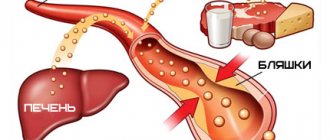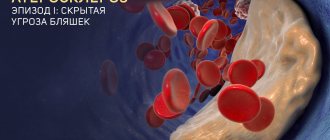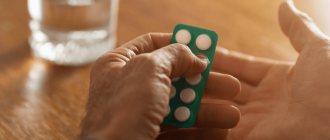What are statins
A large amount of cholesterol in the human body leads to the fact that it begins to settle on the walls of blood vessels, forming plaques that impede blood flow. A plaque attached to a blood clot can clog a vessel. This, in turn, can lead to disastrous consequences: from a heart attack to necrosis of the lower extremities. But not all cholesterol is “bad.” Cholesterol plays an important role in the proper functioning of the body, its tasks include:
- Activation of metabolic processes;
- Participation in the production of bile acid;
- Protecting body cells from the influence of external irritants.
And so, when our body gets too much LDL (low-density lipoprotein, or “bad” cholesterol) and too little HDL (high-density lipoprotein, or “good” cholesterol), problems begin. Statins were invented to prevent them.
Statins stop the production of the enzyme responsible for the formation of cholesterol. In addition, these medications thin the blood and restore damaged vessel walls.
results
From 1986 to 2014, 11 papers were published that met the criteria for inclusion in the meta-analysis. The studies assessed the effect of therapy in 1034 patients, and the study duration ranged from 4 to 12 weeks. Patients were treated with atorvastatin 40 mg, simvastatin 2.5 to 20 mg, rosuvastatin 10 mg, lovastatin 20 mg, pravastatin 40 mg and fluvastatin 80 mg.
- No significant differences were found in the levels of triglycerides, total cholesterol and HDL cholesterol when drugs were administered in the morning and evening hours. However, evening statin administration was associated with a more favorable effect on LDL cholesterol. The mean difference was: total cholesterol, 1.68 mg/dL (95% CI: -0.33-3.69; P=0.10), HDL, 0.05 mg/dL (95% CI: -0.77-0.87; P=0.90), triglycerides, 1.66 mg/dL (95% CI: -2.68 to 5.99; P=0.45), LDL, 3.24 mg/dL (95% CI: 1.23–5.25; P=0.002).
- A subgroup analysis of short half-life statins revealed no statistically significant differences between morning and evening administration of the lipid-lowering drug in HDL and triglycerides, but an advantage of evening administration in changes in total cholesterol and LDL. The mean difference was: HDL, 0.28 mg/dL (95% CI: -1.49 to 2.06; P=0.75), triglycerides, 0.97 mg/dL (95% CI: -13.54 to 15.48; P=0.90), total cholesterol, 12.10 mg/dL (95% CI: 5.25–18.95; P=0.0005), LDL, 9.68 mg/dL (95% CI: 3.32 -16.03; P=0.003).
- An analysis including patients prescribed long-half-life statins did not show significant differences in triglycerides, cholesterol and LDL, but a superiority of the evening dose in terms of changes in HDL. The mean differences were: total cholesterol, 0.70 mg/dL (95% CI: -1.40 to 2.80; P=0.51), HDL, -0.01 mg/dL (95% CI: -0.94 to 0.92 P=0.98), triglycerides, 1.72 mg/dL (95% CI: -2.82 to 6.27; P=0.46) and HDL, 2.53 mg/dL (95% CI: 0.41–4.64; P=0.02).
- One of the three studies that assessed adherence found that morning dosing was associated with better compliance, while the other two had a neutral effect.
Source:
Awad K, Serben M, Person P, et al. Journal of Clinical Lipidology 2021 June.
Who is prescribed statins?
Since statins lower cholesterol levels, they are prescribed to the following categories of patients:
- People with high blood cholesterol;
- People who have had a heart attack;
- People suffering from coronary artery disease;
- Persons with hypertension;
- Patients with obesity, diabetes mellitus;
- People with a hereditary predisposition;
- Patients with acute coronary syndrome
Although statins are effective in lowering cholesterol levels, they are not prescribed to all patients with high LDL levels.
Mechanism of action
Currently, it is customary to separate lipid and non-lipid (pleiotropic) mechanisms of action of statins (E.A. Koval, 2007).
The main lipid mechanism of action of statins lies in blocking the activity of a key enzyme - 3-hydroxy-3-methylglutaryl-coenzyme A reductase (HMG-CoA reductase), which takes part in the synthesis of cholesterol in the liver. Since cholesterol is the main element of intracellular metabolism, in case of its deficiency, receptors for the main transport form of cholesterol - apoB - are actively expressed on the cell surface, as a result of which the main transport form of cholesterol - LDL and VLDL, triglycerides (TG) are captured from the blood. The level of TG in the blood is greatly influenced by lipophilic statins, which block the synthesis of VLDL and the inclusion of the apoB protein in their composition.
Statins can increase the level of HDL cholesterol, regardless of the degree of decrease in the concentration of LDL cholesterol in the blood. Thus, statins have a positive effect on all parts of lipid metabolism in atherosclerosis.
Moreover, numerous clinical studies have found that, at least in high-risk patients, lower TC and LDL-C levels are associated with a statistically and clinically significant reduction in the risk of death from cardiovascular disease. This is why TC and LDL-C levels remain the main recommended therapeutic targets in these guidelines
A meta-analysis of 9 large studies showed a strong correlation between the reduction of LDL cholesterol with statins and a decrease in intima-media thickness (IMT) in the carotid arteries (every 10% decrease in LDL cholesterol is associated with a 0.73% decrease in IMT thickness in year).
The mechanism for the beneficial effects of lowering lipid levels is not fully understood. A decrease in the severity of atherosclerotic lesions is observed only in a small proportion of patients; in addition, at least six (6-12) months are required for the development of the clinical effect of the lipostatic action of the drugs. The action of statins may be based on factors such as plaque stabilization, a decrease in the severity of endothelial dysfunction with a decrease in epithelial thrombogenicity.
The neuroprotective potential of HMG-CoA reductase inhibitors is discussed. In a pilot study, a lower degree of severity of neurological symptoms was revealed if IS occurred during treatment with statins.
Contraindications for statin treatment
- Kidney and liver problems;
- The period of bearing a child and breastfeeding;
- Susceptibility to the components of the drug;
An important role in the practice of using statins is played by the fact that in Russia a very small percentage of patients take medications after their prescription. If in America 95% of patients take medications, in Europe this figure reaches 55%, but in our country it is a modest 12%. There are many reasons: fear and distrust of medicine and the habit of most Russians to let everything take its course.
Medicinal herbs
The following medicinal plants are used to remove “bad” cholesterol from the body:
- Immortelle;
- Sage;
- Melissa.
Decoctions are prepared from them and drunk three times a day. It is recommended to make a fresh decoction daily.
Propolis
Not only medicinal herbs are used in folk medicine to normalize lipid metabolism. Propolis tincture is one of the most effective natural remedies.
To prepare it, take 5 drops of propolis and dissolve in a glass of boiled water at room temperature. You should drink the tincture in the morning, half an hour before meals. The course of treatment lasts 3-4 months.
Statins - pros and cons
Even half a century after the invention of statins, doctors continue to argue about the pros and cons of taking these drugs.
Benefits of using statins:
- Reducing mortality from cardiovascular diseases by 20%.
- Patients taking statins have a 50% reduction in the risk of stroke and heart attack.
- The new generation of drugs is absolutely safe and rarely leads to side effects.
- Wide range of choice, medicine is never in short supply.
- Helps dilate blood vessels and reduce blood viscosity.
- Decreased platelet aggregation.
Side effects of statins
Statins have a number of side effects, but the most common ones are harmless. Among them: sore throat, headache, unpleasant, pulling sensations in the muscles and chills. Recent studies show that taking statins accelerates the aging of the body, which leads to a loss of energy and the development of weakness and fatigue. In addition, the disadvantages of these drugs include:
- Relatively high cost.
- Statins also reduce the production of mevalonate, which is a source of many important substances responsible for biological functions in the body.
- Too low a cholesterol level is no less dangerous than a high one. Excessive use of statins can lead to the development of cancer, anemia and liver problems.
Minuses
But there are also unresolved issues in statin treatment. Thus, from 40 to 75% of patients stop taking statins within 1-2 years after starting treatment. Patients name the reasons for this: fear of developing undesirable effects from the instructions for the drug (46%), disbelief that the medicine prolongs life (29.4%), taking a large number of other pills (27.6%), forgetfulness (26.5 %), poor control of blood cholesterol levels while taking medication (18.8%), drug withdrawal by a non-attending physician (13.5%). At the same time, the actual development of undesirable effects on statin therapy was observed only in 11.7% of patients, and their manifestations were mild and moderate in severity.
Muscle symptoms
The incidence of symptoms of muscle damage is 7-29%, according to various sources. These include:
- muscle pain;
- muscle weakness;
- muscle inflammation, determined based on examination of a sample of muscle tissue and/or magnetic resonance imaging (MRI);
- myonecrosis - muscle damage, determined by a significant increase in serum creatine kinase (CK) levels;
- rhabdomyolysis - destruction of muscle tissue with acute kidney damage with an increase in serum creatinine;
- autoimmune myopathy is a rare complication accompanied by severe muscle damage even after discontinuation of the drug;
The reasons for this are not well understood. According to one version, there is a decrease in coenzyme Q10 in muscle tissue and a decrease in the level of vitamin D. The work of mitochondria is affected.
Muscle symptoms occur in 7-29%.
Symptoms usually appear in both arms or legs. The period of appearance is about 4-6 weeks after starting to take statins. Sometimes, with diseases of the joints and ligaments, pain increases. This may be due to muscle weakness. Unusually, physically active people are more likely to suffer from muscle symptoms. One study found that athletes were less tolerant of lipid-lowering therapy.
According to research, these symptoms are rare. But the studies themselves often exclude older patients, those with impaired liver and kidney function, and those taking certain medications, that is, it cannot be said that this is an ordinary elderly person with a “bouquet of diseases.”
Diabetes mellitus and insulin resistance
It has been established that long-term use of statins under certain factors can contribute to the development of insulin resistance and diabetes mellitus. This is evidenced not only by research data, but also by national recommendations of some countries.
Risk factors for developing diabetes when taking lipid-lowering drugs may include:
- high body mass index (BMI);
- elderly age;
- heart failure;
- myocardial infarction in the last six months and high cardiovascular risk;
- family predisposition to type 2 diabetes;
- Asian race;
- smoking, alcohol abuse.
Effects on the liver
When taking statins to reduce the negative effect on the liver, you must avoid taking:
- alcohol;
- drugs that are metabolized in the liver along the same pathways (for example, amiodarone, sulfonamides, methyldopa, cyclosporine).
Statins can negatively affect a damaged liver.
They should not be prescribed for active viral hepatitis until liver parameters return to normal.
Drug interactions
Statins have multiple effects. This is due to the fact that they do not act in isolation, but affect many chemical reactions in the body. This is especially important in patients taking multiple medications for cardiovascular diseases.
Myths about statins:
Diet can replace statins
A recent study conducted by University of Toronto nutrition professor David Jenkins found that when subjects followed a special diet that harmoniously combined cholesterol-lowering foods, their LDL levels actually dropped.
The nuance is that the diet was compiled by professional doctors individually for each participant. At the same time, the experiment lasted six months and its results, although comparable to the effects of statins, were still worse. In practice, the average person is unlikely to strictly comply with all the requirements of the diet, which can only harm themselves. Therefore, before going on such a diet, be sure to consult with a specialist.
Taking a break from taking statins won't hurt
The prescribed drug should be taken daily.
There are no “buts” here. If you take a break, your cholesterol level will quickly return to its previous level and all treatment will go down the drain. Also, discontinued treatment may increase or even exceed the initial level of cholesterol in the blood. Regular use of these medications reduces the risk of side effects. In addition, statins must be taken strictly in the evening, preferably an hour before going to bed and in a constant dosage. Previously, when prescribing, they used the tactic of gradually increasing the dose, but recent studies show that this does not lead to an improvement in the patient’s condition.
Statins provoke the development of diabetes mellitus
This statement is only partly true. Studies have shown that among almost 18 thousand subjects taking statins, diabetes mellitus developed in only 275 people. At the same time, in patients taking placebo, it developed in 220 cases. This increase in incidence is explained by the initial predisposition to diabetes in the subjects.
Statins kill the liver
Statins slow down the work of one of the main enzymes involved in the synthesis of cholesterol - HMC-CoA reductase. This leads to a decrease in cholesterol synthesis in the liver, but does not cause toxic effects. At the same time, statins are potent medications prescribed for a long term. Therefore, if you have liver disease, you should approach taking statins with caution. But even for such patients, pharmacists have developed special groups of drugs that reduce the risk of complications. Also, patients with liver hepatosis, hepatitis and other similar diseases when taking statins must follow a diet low in animal fats.
The experience of giving presentations on the use of one of the most widely used classes of drugs today (and the first in terms of sales volumes) - statins, gave the author the opportunity to evaluate the set of questions that are asked in one form or another in a variety of audiences. This work is an attempt to formulate answers to the most common of them.
What class of drugs do statins belong to?
The answer to this question seems obvious. Nine out of ten doctors will immediately answer that statins are cholesterol-lowering drugs. A slightly smaller number, but also a very significant one, will remember that statins inhibit the enzyme HMG-CoA reductase, which converts acetyl-CoA into mevalonic acid, a substance from which cholesterol is formed through a series of transformations. This process occurs inside cells, most actively in hepatocytes. The consequence of inhibition of intracellular cholesterol synthesis is a decrease in its level in the cell. The cell satisfies the need for it by increasing the uptake of cholesterol from the blood, where its concentration, accordingly, decreases. The crux of the matter, however, is not this. There are a significant number of other lipid-lowering drugs, the use of which, however, does not lead to an increase in life expectancy in high-risk patients. Statins differ in that they reduce the risk of adverse outcomes of atherosclerosis. From this point of view, the indication for prescribing a statin is not the level of lipids, but the level of risk.
This key difference between statins and other drugs that correct lipid metabolism sometimes gives reason to consider statins as a separate class of drugs.
However, for convenience, statins are most often called lipid-lowering drugs.
Should statins be prescribed if lipids are normal and to what level should lipids be reduced?
The prescription of statins, according to modern concepts, is indicated for those patients who have an increased risk of developing adverse outcomes of atherosclerosis. Statins reliably and significantly reduce this risk. However, the level of low-density lipoprotein cholesterol (LDL) does not necessarily have to be elevated. Or, in other words, at higher risk, more stringent requirements are placed on LDL levels.
Different countries approach this problem differently. Thus, in the United States today, the prevailing tactic is to more aggressively lower LDL levels. In high-risk groups (risk of death from complications of coronary artery disease > 20% over 10 years), according to American experts, LDL levels should be achieved
The European recommendations of 2003, on the basis of which the domestic ones issued in 2004 are based, use a slightly different approach. The risk is assessed in relation not only to complications of coronary artery disease, but also to other complications of atherosclerosis, primarily cerebrovascular episodes.
These recommendations state that normal values for total cholesterol are 5 mmol/L and LDL cholesterol is 3 mmol/L. If the risk determined from the tables (see figure) or a special calculator is less than 5% over 10 years, the subject is recommended to change his lifestyle. If the risk is higher, a decision is made on drug intervention (first of all, the issue of prescribing statins is considered).
If there are already signs of atherosclerosis or diabetes mellitus, a total cholesterol level below 4.5 mmol/l and an LDL cholesterol level below 2.5 mmol/l are considered normal. To achieve these target levels, statins should be used in these patients.
Before discharge from hospital, patients with myocardial infarction often have normal cholesterol levels. Should statins be prescribed to such patients?
An episode of exacerbation of coronary artery disease is accompanied by fluctuations in cholesterol levels. This is due both to the disease itself and to the use of certain medications (for example, heparin). Today, to determine the “true” lipid level, it is recommended to use data obtained upon admission of the patient to the hospital. For this purpose, determination of blood lipid levels is included in the list of mandatory laboratory parameters that are recorded in the patient during hospitalization. Lipids will return to pre-infarction levels only after three months. In cases where data on lipids on admission are not available, statins should be prescribed based on diagnosis in moderate dosages.
With the statin, blood lipid levels have normalized - how long should the patient continue to take this medicine?
Despite the obviousness of the answer to this question, it arises with enviable frequency.
However, if the answer is precise, then the experience with statins in controlled studies is limited to 3-5 years. Then, after the end of the study, as a rule, patients are recommended to continue taking the drug.
The longest period during which the fate of patients participating in the statin project was tracked was 10 years. These are patients from the 4S trial, the first study to show improved survival in patients treated with simvastatin. The results of this observation suggest that continuing statin therapy for such a long time does not increase the number of side effects.
The differences in the incidence of cardiovascular events that were achieved during the five-year study period, when the effects of the drug were compared with placebo, persisted five years after the end of the study, when the majority of study participants began taking the active drug.
In other words, the answer to this question may sound like this. If indicated, statins should be used long-term, at least until the doctor has something more effective in his hands.
Can statins be prescribed to women before menopause?
Yes, it is possible, however, in the case where the risk of developing adverse outcomes of atherosclerosis makes such a prescription necessary, the woman should be warned about the need for adequate contraception, since the prescription of statins is contraindicated for pregnant women.
Breastfeeding is also a contraindication for the use of statins.
Up to what age should statins be prescribed?
As the results of recent studies conducted with elderly patients show, advanced age is not a reason to deprive such patients of statins. It should be noted, however, that with increasing age, the effectiveness of statins decreases, as other life-limiting conditions of the patient come to the fore. In this case, adding statins to a large list of other medications may not be appropriate. In any case, the decision is always made individually.
Can statins be given to children?
There are a very small number of hereditary conditions for which it is acceptable to prescribe statins to children. However, decisions in this regard should only be made by lipidologists.
How to use the non-lipid effects of statins?
Isolation of the so-called non-lipid (or pleiotropic) action of statins is very fashionable, but rather conditional. Firstly, this is due to the mechanism of action of these drugs. Blockade of mevalonic acid synthesis affects the level of all products formed from this precursor. Therefore, it is very difficult to separate one effect from the other. Secondly, the lipid effect itself can be formed not only by reducing the level of cholesterol synthesis in the liver, but also indirectly, for example, through the influence on special nuclear receptors that regulate the expression of a very large number of genes.
Nevertheless, these effects traditionally include effects on endothelial function, hemostasis factors, and platelets. A fairly powerful anti-inflammatory effect of this class of drugs, etc., has been described.
We are a long way from adding separate indications for statins for these effects, although this additional action may be useful in some patients. This primarily applies to people who, in addition to the risk of dying from cardiovascular disease, have certain diseases, such as rheumatoid arthritis, the course of which statins can improve.
It must be said that many experts believe that the main effect of statins—improving survival in a high-risk group—is rather a consequence of a non-lipid effect. Whether this is true or not will be shown by the results of additional studies currently being conducted.
How to choose a statin?
The group of statins today consists of a number of drugs registered, including in our country. These are lovastatin, simvastatin, pravastatin, atorvastatin, fluvastatin and rosuvastatin. As you can see, there is a choice. However, it is often influenced by only one parameter – the price of treatment. This approach is, of course, wrong. Although the fact that all statins reduce the risk of adverse outcomes of atherosclerosis to one degree or another is beyond doubt, rigorous evidence for this in large multicenter studies was obtained only for lovastatin, simvastatin, pravastatin and atorvastatin. No such studies have been conducted with fluvastatin. Rosuvastatin is a relatively young drug; studies on its use have not yet been completed.
There is reason to believe that the effectiveness of statins on survival correlates to a certain extent with the severity of their lipid-lowering effect. From this point of view, the least effective is fluvastatin, then in order of increasing lipid-lowering effect are pravastatin, lovastatin, simvastatin, atorvastatin and finally rosuvastatin.
The largest number of studies that did not show a significant reduction in adverse outcomes were conducted using pravastatin. The two best studied drugs from this group are simvastatin and atorvastatin. Studies involving the largest number of patients have been conducted using these drugs.
There are few direct comparisons of statins in studies examining the risk of adverse outcomes.
The recently completed IDEAL (Incremental Decrease in Clinical Endpoints Through Aggressive Lipid Lowering) study compared simvastatin and atorvastatin. The study included patients with characteristics very similar to those included in the first successful statin project, the 4S study. A total of 8888 patients who had suffered myocardial infarction and were selected for treatment with statins were divided into two groups: the first received simvastatin (20 mg / day, increasing the dosage to 40 mg if the cholesterol level remained above 190 mg/dl), the second received atorvastatin ( 80 mg/day; when LDL levels dropped below 40 mg/dL, the dose was reduced to 40 mg/day).
After almost a five-year follow-up period, a significant difference in the incidence of the primary end point (coronary death + hospitalization for heart attack + successful resuscitation after cardiac arrest) was not achieved. Myocardial infarction developed not much, but significantly less often in the atorvastatin group. Mortality from coronary artery disease was identical in both groups. Although adverse events that could be a consequence of statin use were reported at similar rates in both groups, drug discontinuation was more common in the atorvastatin group. The incidence of myalgia and cases of elevated liver enzyme levels was also higher when taking atorvastatin.
In other words, using high doses of atorvastatin may have (albeit small) benefits. However, the price for these benefits is more side effects.
For our country, where the difference in the cost of 40 mg of simvastatin and 80 mg of atorvastatin remains significant, the conclusion could be as follows. Simvastatin at a dose of 20–40 mg should be prescribed. If target LDL levels cannot be achieved, a more aggressive statin or combination therapy should be considered.
How to choose a statin dose?
The choice of statin dose is another stumbling block. The tradition of starting treatment with microscopic doses was born in connection with the long-standing belief of conservative doctors that it is better to prescribe at least something than nothing. Today it is already clear: treatment with statins should be carried out using dosages that have been tested in large clinical trials. For the most commonly used statins, these doses are: simvastatin - 20 and 40 mg / day, atorvastatin 10-80 mg / day.
What to do if a statin does not lower lipids sufficiently?
Indeed, not all patients manage to achieve the target LDL level. Moreover, every year, target LDL levels are decreasing more and more, i.e., the number of patients in whom statins were not effective enough is increasing. Several ways out of this situation have been proposed. First, the use of active statins in maximum dosages - atorvastatin at a dose of 80 mg and rosuvastatin at doses of 20 and 40 mg. Unfortunately, there is a kind of “6% rule” for statins. According to him, doubling the dosage of a statin leads to an increase in its effectiveness on LDL levels by only 6%. Moreover, when directly comparing the effects of different statin dosages on specific endpoints, as was done in the TNT (Treating to New Targets study) study, which compared atorvastatin doses of 10 and 80 mg, the differences in the frequency of endpoints, although reaching a significant level , but this difference turned out to be slightly greater than 2% (and this is with an eightfold increase in the dose!).
The second way is a combination with a medicine from another group. Pharmaceutical companies are actively searching in this direction. However, only one drug has reached clinical use (except for combinations with “old” drugs - fibrates, nicotinic acid) - ezetimibe. This medicine, acting on a specific cholesterol transporter in the intestinal wall, reduces its absorption from the lumen of the small intestine and thus lowers its concentration in the blood by blocking the absorption of dietary cholesterol and bile cholesterol. By itself, ezetimibe has a modest effect - it reduces LDL cholesterol by about 20%. At the same time, when added to a statin, it provides a powerful additive effect. Thus, the combination of 10 mg of any of the statins and 10 mg of ezetimibe is equivalent to the administration of 80 mg of statin, if the effect is assessed by the effect on lipids. There are no data yet regarding the effect of this combination on disease outcomes.
About the side effects of statins
The problem of minimizing side effects during treatment with any drug is quite acute. However, for drugs used to reduce the risk of adverse outcomes of a disease in large populations, this problem is especially relevant. In other words, what is the benefit of a medicine for a specific patient is unclear, since the effects appear only when analyzing large groups of patients, but the harm is caused to a specific person.
Statins are one of the most commonly used drugs today. Fortunately, the incidence of adverse reactions due to their use is low.
However, recently the problem of statin safety has become increasingly used as a tool in the competitive struggle of manufacturers. In our country, this approach leads to the opposite effect. Having heard about the side effects of one or another statin, many doctors, without much thought, stopped prescribing statins altogether. Those who, due to conservatism, had not prescribed them before, received in their hands, as it seems to them, a very important weapon against drugs of this group.
The fact that the pathos of the majority of “safety fighters” is not associated with the desire to achieve benefits for patients is clearly illustrated by the fact that in the absence of sponsorship support for this kind of struggle, in our country a drug such as metamizole, better known, which is banned in most countries, is still used. under the name Analgin.
All this, of course, does not exclude the need to remember side effects.
What to do if your liver enzyme levels are elevated?
Elevated liver enzymes are the most common side effect of statins. It is observed in 0.5–2% of cases and depends on the dose of the drug. At the same time, other signs of hepatotoxicity have not been recorded so far against the background of statins.
Although liver diseases are on the list of contraindications to the use of statins, cases of worsening of these diseases due to their use have not yet been described. In patients with hepatitis C and B who have elevated levels of transaminases, the prescription of statins does not lead to a worsening of the disease. Treatment of hyperlipidemia in patients with fatty liver disease may even reduce the level of transaminases in the blood.
However, it is common practice to reduce the dose of the drug when liver enzyme levels increase more than 3 times the normal value. If the initial blood test shows such an increase, you should start with lower doses and monitor enzyme levels more frequently. Sometimes changing the drug leads to normalization of liver enzyme levels.
What is statin myopathy and statin rhabdomyolysis?
One of the most frequently asked questions regarding statins is largely due to some confusion in concepts. First a few definitions:
Myopathy is a general name for any muscle disease. It can be congenital or acquired, observed at birth or manifested throughout life.
Myalgia is pain or muscle weakness that is not accompanied by an increase in creatine phosphokinase (CPK) levels. The syndrome completely resolves within 2–3 weeks after discontinuation of statins.
Myositis is muscle symptoms accompanied by an increase in CPK.
Rhabdomyolysis is muscle symptoms characterized by a significant increase in CPK levels (usually more than 10 times) and an increase in blood creatinine levels. Rhabdomyolysis is usually accompanied by the appearance of brown urine and myoglobinuria. The latter causes acute renal failure and in significant cases leads to the death of the patient. The diagnosis can be confirmed by muscle biopsy.
The whole spectrum of muscle lesions can occur against the background of statins - from myalgia to rhabdomyolysis.
In which patients should side effects be expected?
The myotoxic effect of statins depends on the concentration of the drug in the blood and is associated with conditions that increase it.
These factors are age (especially over 80 years of age, more often in women than men), poor nutrition, comorbidities (for example, renal failure, especially due to diabetes mellitus, or liver failure), polypharmacy, the postoperative period, excessive alcohol consumption and grapefruit juice.
A number of medications significantly increase the risk of complications. These are fibrates (especially gemfibrozil), nicotinic acid, cyclosporine, antifungals (azoles), macrolide antibiotics, verapamil, amiodarone.
Theoretically, certain characteristics of individual statins may also be important. These are lipophilicity, the degree of binding to plasma proteins, and potential interaction with other drugs (especially through the cytochrome P450 CYP3A4 system). In the experiment, lipophilic statins had the greatest myotoxic effect.
Hydrophilic statins practically cannot penetrate into cells due to passive diffusion. At the same time, they are included in hepatocytes due to active transport, for example, with the help of polypeptide C, which transports organic anions. In the experiment, lipophilic statins - atorvastatin, simvastatin and lovastatin, in contrast to hydrophilic pravastatin, damaged muscle cells more and caused a greater increase in CPK levels.
Cerivastatin is the most lipophilic statin, and perhaps this fact was responsible for the large number of cases of rhabdomyolysis with its use, which led to the withdrawal of the drug from the market and the cessation of its production.
Combination of statins with other lipid-lowering drugs
Another possibility for adverse treatment effects to occur is the combined use of statins with other drugs that have lipid-lowering effects. The widespread use (especially in Western countries) of this combination stems from modern ideas about the need for intensive reduction of lipid levels. Today, according to some recommendations, in patients with a high risk of complications of atherosclerosis, LDL should be reduced to a level of less than 1.8 mmol/l. These recommendations explicitly state that combination therapy is often necessary to achieve this level. For combination therapy, a combination with nicotinic acid and an inhibitor of cholesterol adsorption in the intestine, ezetemibe, is used. The combination of statins with nicotinic acid is used quite rarely due to the large number of side effects of the latter. Only isolated cases of rhabdomyolysis have been described when used in combination with lovastatin.
The combination with ezetimibe has not yet resulted in serious side effects.
To further reduce triglyceride levels, especially in patients with diabetes, a combination of statins and fibrates metabolized by cytochrome P450 CYP3A4 is often used.
The riskiest combination is statins and gemfibrozil. It was the combination of cerivastatin with gemfibrozil that caused a large number of myotoxic adverse reactions. Gemfibrozil undergoes extensive glucuronidation by glucuronyl transferase, in particular its isoforms UGT1A1 and UGT1A3, which are also involved in the glucuronidation of statins. Glucuronidation is the main method for eliminating active statin metabolites.
Another fibrate, fenofibrate, interacts with two other isoenzymes, UGT1A9 and UGT2B7, and therefore has a lower potential risk of interaction with statins.
It should be borne in mind that the frequency of complications is still very low, so there is no reason yet to prohibit such combinations. However, one should remember the possibility of the described interaction and monitor such patients more carefully.
What to do if myotoxic effects of statins are detected or suspected?
The necessary actions of a doctor in this situation are summarized in the table.
Naturally, the topic of treating patients with atherosclerosis with statins is so vast that it is impossible to answer all the questions a doctor may have within the framework of such a short article. Moreover, the number of publications relating to this class of drugs is growing exponentially, and some issues are still waiting to be resolved.
Still, we can state with some satisfaction that in our country the number of patients taking statins is growing every year. We hope that this publication will help strengthen this trend.
Should you take statins?
As a result, we find that statins are quite effective drugs, but at the same time they have a number of side effects. For many older people, this medicine is vital, therefore, if your doctor has prescribed you statins, you should under no circumstances ignore this prescription, adjust the treatment regimen yourself, or skip doses of the medication. Everything is poison and everything is medicine. The only difference is in proper use. Physical activity, a properly selected diet, timely and correct intake of the drug and regular consultations with a doctor will help reduce the risks of complications and provide you with a calm old age, despite problems with cholesterol.
Diet food
About a fifth of cholesterol enters the body through foods. This allows you to correct fat metabolism using food. People who have been diagnosed with hypercholesterolemia should completely avoid the following foods and foods:
- Lard and fatty meat;
- Fried foods;
- Smoked meats, sausages, frankfurters;
- Offal;
- Milk with a high percentage of fat content;
- Baking and muffins.
All these dishes should be excluded from the diet, replacing them with a large amount of fresh vegetables and fruits.
The amount of table salt should be reduced to 7 grams per day. The daily calorie content should not exceed 2000 kcal.
Whole grain bread is recommended; the amount of legumes in the diet should be constant. Breakfast should consist mainly of cereal porridges.
Is it possible to stop taking pills forever?
After you've followed a healthy lifestyle and taken foods rich in natural statins for three months, get your cholesterol levels checked. If during this time positive dynamics have emerged (that is, the level of harmful fractions decreases and the level of beneficial fractions increases), you can continue treatment with natural remedies.
Otherwise, you will have to take medications as prescribed by your doctor to normalize fat metabolism. Leaving it in a state of instability is highly discouraged.
You should have your cholesterol levels checked annually. If indicators worsen, consultation with a doctor is required.











